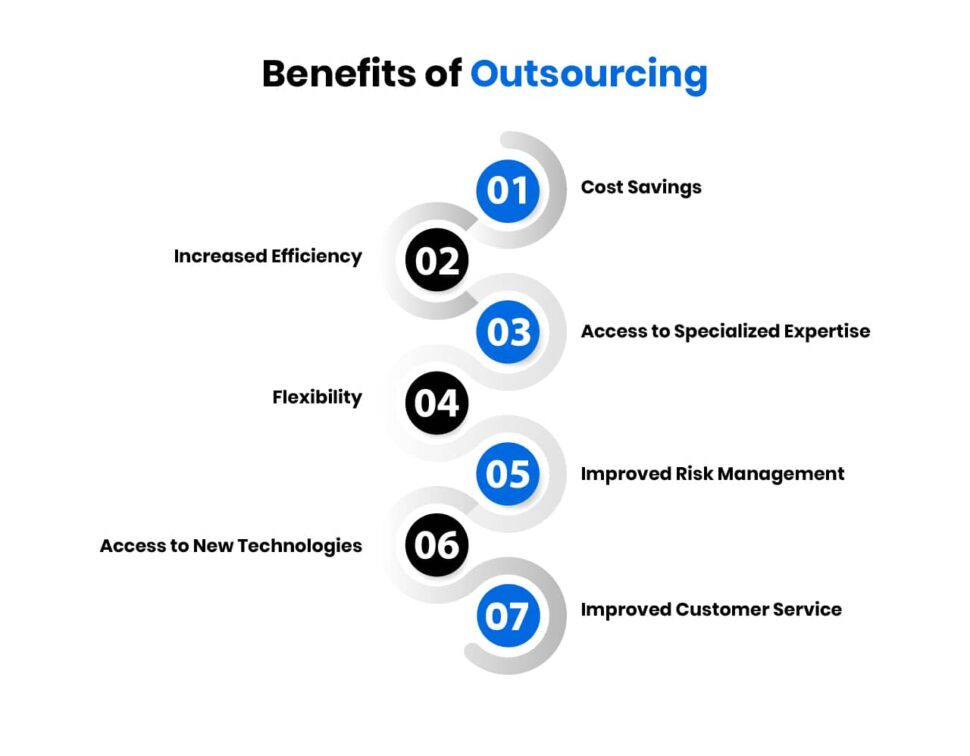In today’s digital age, businesses of all sizes rely heavily on information technology services to maintain their operations, however, businesses typically feel they are spending a bomb on IT without a surety of its success. As an entrepreneur or a business owner, your primary agenda is to invest in the development of software that is efficient and yet cost-effective.
In this guide, we will discuss in detail how outsourcing can help, factors to consider, benefits it offers, and advantages and disadvantages you must be aware of before outsourcing. So let’s begin.
What is Outsourcing, and How It Helps?
Outsourcing is hiring an external organization or individual to perform specific business functions or services that would otherwise be carried out internally. This practice has become increasingly popular in recent years due to its many benefits to businesses of all sizes.
As a business, you’ll pay less for the same effort, tap into an extensive resource base, provide better value, and mitigate risks with better support. All the while, you can focus on your core competency, giving your business an even better leg up on the competition.
Statistics can be an eye-opener for this subject. Over the past few decades, the outsourcing industry has exploded and grown from nothing to a multi-trillion US-dollar business worldwide.
- The IT Outsourcing Market size is estimated at USD 617.69 billion in 2024, and is expected to reach USD 806.53 billion by 2029, growing at a CAGR of 5.48% during the forecast period (2024-2029). [Source: Mordor Intelligence]
- The global outsourcing market is projected to reach USD 425.19 billion in 2026, valued at USD 318.5 billion in 2020. [Source: Global News Wire]
- The most revenue will be generated in the US compared to the global level at USD 156.20 billion in 2023, with the average spend per employee in the IT Outsourcing segment projected to reach USD 123.60 in 2023. [Source: Statista]
- IT Services make up 72% of all global outsourcing, i.e.; out of $92.5 billion in contracts by global outsourcing firms, $66 billion came through information technology services. [Source: ISG]
- 83% of small businesses want to maintain or increase spending on outsourced services in 2023. [Source: Clutch]
These statistics are a sign that outsourcing can be a sure shot and a perfect solution to reduce some business costs. Let us now understand the various benefits of outsourcing that support the approach on a wide scale.
Benefits of Outsourcing
Outsourcing offers many benefits to businesses of all sizes. From IT outsourcing cost savings and increased efficiency to access to specialized expertise and new technologies, outsourcing can help businesses stay competitive and adapt to changing market conditions. Let us now explore some of the key benefits of outsourcing.
- Cost Savings
- Increased Efficiency
- Access to Specialized Expertise
- Flexibility
- Improved Risk Management
- Access to New Technologies
- Improved Customer Service

Cost Savings
By outsourcing certain functions, businesses can avoid the costs associated with hiring and training new employees, purchasing equipment and software, and maintaining infrastructure. Outsourcing can also help businesses avoid the costs of providing employee benefits, such as health insurance and retirement plans.
Increased Efficiency
Outsourcing can help businesses become more efficient by allowing them to focus on their core competencies. By delegating non-core functions to external providers who specialize in those areas, businesses can free up internal resources to focus on what they do best. This can increase productivity, faster time-to-market, and improve customer satisfaction.
Access to Specialized Expertise
Businesses get access to specialized expertise that may not be available internally. For example, a small business may need more resources to hire a full-time IT professional. But by opting for outsourcing IT services, they can access a team of experts who can provide high-quality support and advice.
Flexibility
Outsourcing can also give businesses greater flexibility to adapt to changing market conditions. By outsourcing non-core functions, businesses can scale up or down more quickly as needed without worrying about the costs and logistics of hiring or laying off employees.
Improved Risk Management
Businesses can manage risk by transferring certain functions to external providers with more expertise and experience. For example, outsourcing payroll processing can help ensure compliance with tax laws and regulations, reducing the risk of penalties or fines.
Access to New Technologies
Outsourcing can also provide businesses access to new technologies that may not be available internally. By partnering with external providers, you are at the forefront of new technology developments; helping your business gain a competitive edge and stay ahead of the curve.
Improved Customer Service
Outsourcing can also help businesses improve customer service by providing access to dedicated teams of professionals specializing in customer support. This can lead to faster response times, higher customer satisfaction, IT cost reduction, and improved customer retention.
IT Outsourcing Pricing Models You Must Know
With IT outsourcing becoming common practice for businesses, knowing the several pricing models is necessary. Each model has advantages and disadvantages; the suitable model depends on the project’s scope, requirements, and budget. The following IT outsourcing pricing models will help you make an informed decision.
Fixed Price Model
The outsourcing provider and the client agree on a fixed project or service price in this model. The fixed price model helps clients to have better control over their budgets and gives them a clear idea of the cost involved.
This model is ideal for small projects with well-defined requirements, as it offers predictability and eliminates surprises. However, the downside of the fixed-price model is that changes in the project scope or requirements may result in additional costs. The vendor may also be incentivized to minimize costs to maximize their profits, which could result in a lower quality of work.
Time and Material Model
In a time and material model, the outsourcing provider charges the client based on the actual hours worked and the materials used for the project. This model is suitable for larger projects with evolving requirements and scope, as it offers flexibility and allows for changes as the project progresses. This model also provides better transparency and gives clients tighter control over the project’s progress.
However, the downside of this model is that it may take time to predict the project’s final IT outsourcing cost, and the vendor may be incentivized to work for longer hours, resulting in higher costs for the client.
Dedicated Team Model
In a dedicated team model, the outsourcing provider assigns a dedicated team of developers, testers, and other specialists to work exclusively for the client. This model is ideal for long-term projects with evolving requirements and scope, as it allows for close collaboration between the client and the outsourcing provider.
The dedicated team model gives clients greater control over the project, as they can manage the team directly and modify the project’s scope as needed. It also offers better communication and ensures the team’s skills and expertise match the client’s requirements.
However, the dedicated team model may result in higher costs, as the client must pay for the team’s salaries, benefits, and other expenses.
Outcome-Based Model
In an outcome-based model, the outsourcing provider is paid based on the results or outcome of the project rather than the time or effort put into it. This model is ideal for projects with specific, measurable objectives, such as software development or digital marketing campaigns.
The outcome-based model incentivizes the outsourcing provider to deliver high-quality work and achieve the desired results, as their payment is tied to the project’s success. However, this model may be challenging to implement and require more investment upfront to develop the necessary infrastructure and processes to measure outcomes accurately.
Hybrid Model
In a hybrid model, the outsourcing provider and the client agree on combining two or more pricing models to suit the project’s specific requirements. For example, the client may opt for a fixed price model for the project’s initial phase and switch to a time and material model for subsequent phases.
The hybrid model offers greater flexibility and allows clients to take advantage of the benefits of different pricing models while minimizing their drawbacks. However, this model may be more challenging and require significant project management and communication investment.
Advantages of Offshore Outsourcing
Cost Savings:
Companies can often get high-quality work done at a fraction of the cost of hiring local developers. This is particularly true in countries with lower labor costs, such as India, China, and Vietnam.
Access to a Larger Talent Pool:
Companies can access skilled developers available elsewhere by outsourcing work to other countries. This can be particularly beneficial for companies looking for specialized expertise or a unique project requiring a specific skill set.
Faster Time to Market:
With a larger team working on the project, the development process can be completed more quickly. This is particularly important in industries where time to market is critical, such as software and technology.
24/7 Work Cycle:
Since the development team is in a different time zone, work can be done around the clock. This can be particularly useful for companies that must meet tight deadlines or have a large workload.
Improved Focus on Core Business Functions:
This can be particularly beneficial for smaller companies needing more resources to hire a large development team in-house.
Disadvantages of Offshore Outsourcing
Communication Challenges:
With team members in different countries, time zones, and cultures, it can take time to communicate project requirements, deadlines, and feedback effectively. Language barriers can also make communicating project requirements and feedback challenging.
Quality Control Issues:
Since the development team is in a different country, ensuring the work meets the company’s quality standards can take time and effort. This can lead to delays and additional costs as the work may need to be redone.
Intellectual Property Concerns:
Companies may be hesitant to share sensitive information with a foreign team, particularly if the country has a less robust legal system for protecting intellectual property.
Also read: Legal Issues to Consider in application development
Time and Resource Management:
It can be difficult to effectively manage a team in a different country, mainly if it is large or works on multiple projects. This can lead to delays and additional costs.
Companies must thoroughly research dedicated offshore development partners to ensure they have the expertise, experience, and quality standards to meet their needs.
How to Choose the Right Provider for IT Services
Choosing the right provider for IT services can take time and effort, especially if you’re unfamiliar with the industry or the technical jargon that comes with it. Here are some tips to help you choose the right provider for your business’s IT needs.
Assess Your Business Needs
The first step is to assess your business needs. What kind of services do you require? Do you need help with network management, data backup, and recovery, cybersecurity, cloud services, or all of the above? Once you understand your needs, you can search for providers offering those services.
Check for Industry Experience
Look for providers who have worked with businesses in your industry or have experience with similar business models. This will ensure that the provider understands your unique needs and challenges.
Look for Reviews and Recommendations
One of the best ways to gauge a provider’s quality of service is to look for reviews and recommendations from other businesses. Check online review platforms, such as Yelp or Google, to see what other customers say about the provider’s services. You can also ask for recommendations from other industries or professional network businesses.
Evaluate Technical Expertise
Choosing an IT outsourcing services provider with the technical expertise to meet your needs is essential. Look for providers with a team with certifications in your required services. You can also ask for proof of experience and technical qualifications.
Service Level Agreements (SLAs)
Service Level Agreements (SLAs) are contracts that define the level of service a provider will deliver and the consequences if they fail to meet those standards. Look for providers that offer comprehensive SLAs that meet your business needs. This will ensure that you receive the level of service you require, and the provider is held accountable for any lapses.
Look for Flexibility
Business needs can change quickly, and choosing an IT service provider that can adapt to those changes is essential. Look for flexible service providers that can scale their offerings to meet your business needs. This will ensure that you have the ability to add services as your business grows.
Check for Customer Support
Finally, choosing an IT service provider with reliable customer support is essential. Look for providers that offer 24/7 support and have multiple communication channels, such as phone, email, or live chat. This will ensure you receive timely support whenever needed and your IT issues are resolved quickly.
Choosing the right IT services provider can be daunting, but ensuring that your business operates efficiently and securely is essential. Following these tips, you can choose the right provider for your business’s IT needs.
How Ailoitte can be Your IT Outsourcing Partner
As your business grows, your IT needs will also grow. Ailoitte understands that every business has unique needs and requirements, as we offer scalable IT solutions that can be adjusted to meet the changing needs of your business. Whether you need software development, web development, mobile app development, or any other IT service, we can provide a solution that fits your needs. Whether you need to scale up or down, we can provide the right IT solution by doing a proper cost-benefit analysis for your business.
We are a leading IT outsourcing company that provides cutting-edge technology solutions to businesses of all sizes with cost-effective IT services designed to help you maximize your IT budget. With years of experience and a team of skilled professionals, we can be your trusted partner for all your IT and software development outsourcing needs.
We are committed to delivering high-quality IT solutions that meet the needs of our clients. By adhering to a strict quality assurance process, we ensure that our solutions are of the highest quality, so you can focus on running your business.
FAQ
There are statistics that show that companies can save 30% to even 90% on the overall operating costs.
To outsource effectively, first, define the scope of the project and create a checklist, then find the right service providers and compare the costs, set up a monitoring team, and check for accountability. Maintain proper communication, track performance and be ready to adapt to changes.
Outsourcing is the process of hiring another individual or a company, locally or remotely to perform services or create products. This is a practice usually taken up as a cost-cutting measure.
The top easy ways to reduce expenses and business operating costs are to identify and resolve problems effectively, automate time-consuming tasks, embrace the latest technologies, outsource to experts, tackle variable and fixed costs, avail different vendor bids, use free apps whenever possible etc.
Some of the key benefits of outsourcing IT services are increased productivity and efficiency, access to specialized expertise, flexibility, cost savings, improved risk management, access to the latest technologies, and improved customer service.
Firms outsource jobs for several reasons such as to save costs, cut back on resources, empower their business, experiment with new strategies etc.




















.png)
.png)
.png)



Leave a Comment